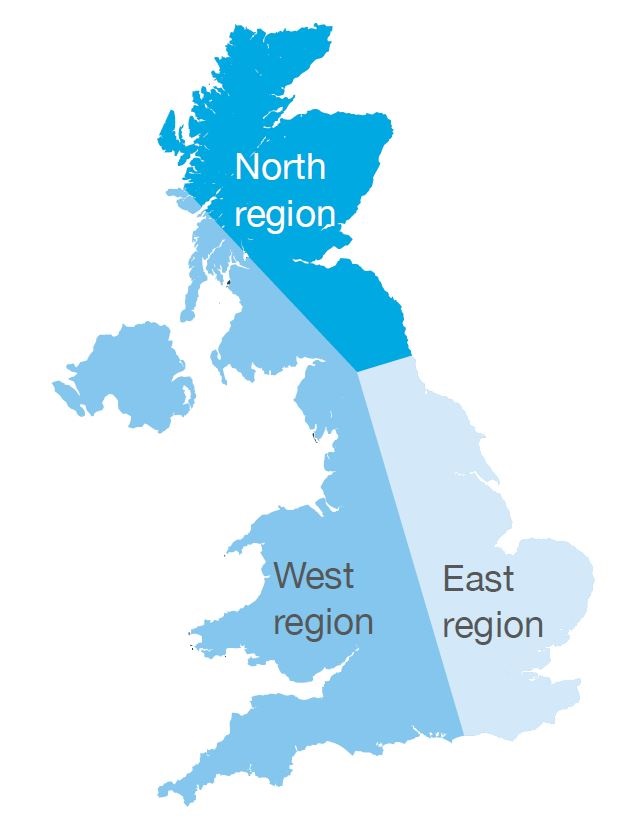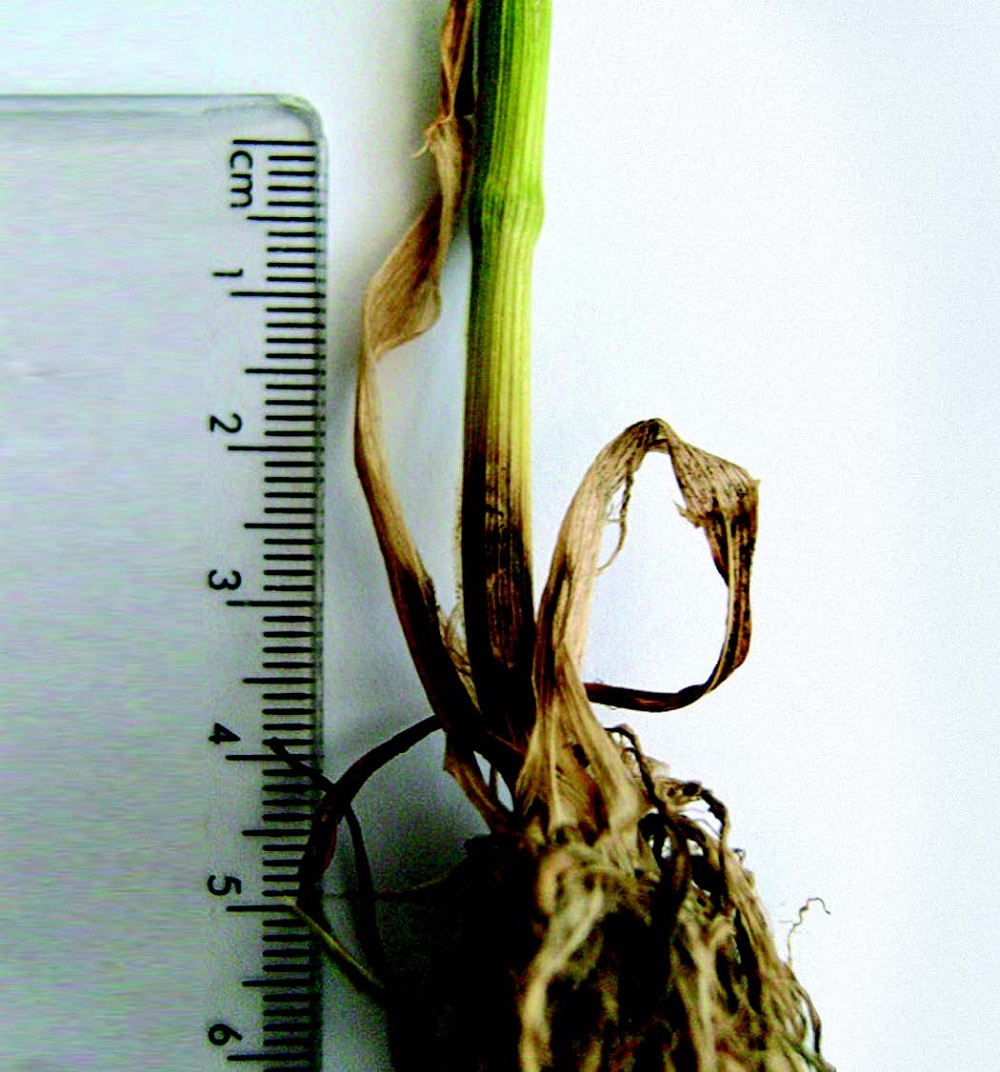- Home
- Knowledge library
- Eyespot in cereals and risk assessment in wheat
Eyespot in cereals and risk assessment in wheat
Eyespot is a common disease in intensive cereal rotations. Use the eyespot risk assessment to inform your rotational, cultivation and drilling strategy, and the need for chemical control.
Cereal disease management homepage
Which cereal crops does eyespot affect?
Eyespot is a common disease in intensive cereal rotations. It affects wheat, barley, oats, rye and triticale.
The disease is most serious in autumn-sown crops, especially when inoculum builds up across the rotation.
It affects wheat more than barley. Although oats are much less susceptible, when infected, they can transfer inoculum between crops.
The disease tends to damage yield only when the lesion penetrates the leaf sheath. This restricts water and nutrient flow to the ear, reduces grain number and size and causes whiteheads.
Associated lodging can also delay harvest, increase grain moisture, reduce grain quality and encourage other diseases.
Moderate or severe eyespot infections can cause yield loss in the order of 10–30%, even in the absence of lodging.
Symptoms of eyespot infection in cereals
Although severe and early attacks of eyespot can kill seedlings, symptoms typically first become visible in early spring.
Symptoms appear as a brown smudge (diffuse margin) at the stem base on one side of the outer leaf sheath.
As the season progresses, symptoms become more distinct with an eye-shaped lesion with a dark, diffuse, margin, usually below the first node.
A central black 'pupil' may be visible: this is a mass of compacted hyphae and is difficult to remove by rubbing.
Symptoms can be confused with sharp eyespot and fusarium foot rot. However, unlike these diseases, eyespot lesions penetrate through the leaf layers, rather than being confined to the outer leaf sheath during stem extension.
As leaf sheaths die off during spring growth, eyespot symptoms may disappear but can reappear later. Look at stem bases from the milky ripe stage to see if eyespot lesions are present.
Severe eyespot infections can weaken stems around the lesion and cause lodging – stems can fall in all directions, as opposed to lodging caused by wind.
Alternatively, whiteheads (bleached ears) may form, where nutrient and water flow is restricted to the rest of the plant.
Eventually, whiteheads may be colonised by sooty moulds and turn black.
The hollow of infected straw is sometimes filled with a grey fungal growth in the region of the lesion.
Life cycle of eyespot
Pathogens
- Oculimacula yallundae (anamorph Helgardia herpotrichoides), W-type (more pathogenic on wheat and barley than on rye)
- Oculimacula acuformis (anamorph Helgardia acuformis), R-type (pathogenic on wheat, barley, rye and triticale)
Mixed R and W-type eyespot infections occur in most UK crops.
Eyespot inoculum overwinters on infected stubble and volunteers. In the UK, the fungus has a sexual and an asexual phase. The sexual phase produces ascospores on stubble after harvest. Dispersed by wind across long distances, these spores infect emerging or young plants throughout the autumn and winter. The asexual phase produces conidia on stubble and trash over the winter. These spores are rain-splashed short distances onto cereal stem bases. The presence of an airborne stage means that surrounding crops can infect first wheat crops in the absence of infected trash. Therefore, the influence of previous cropping is not as large as it was thought to be.
The disease can survive on stubble and trash for three years, especially if buried. Therefore, a one or two year break from cereals does not always reduce eyespot risk. Grass weeds also act as sources of inoculum.
Infection occurs at temperatures above 5° C, with a daytime optimum temperature of 15° C and a nighttime optimum temperature of 10° C. High temperatures inhibit infection. Prolonged humid conditions are conducive to infection. Following infection, the development of symptoms normally takes about 12 weeks, depending on environmental conditions. Dry weather can cause infected outer leaf sheaths to shrivel and die, which may prevent infection from progressing.
.PNG)
Eyespot risk assessment in wheat
Use this risk assessment to guide integrated pest management (IPM) decisions.
Although designed for winter wheat, it can provide a useful indicator of risk for barley, since the same fungi are involved. However, the calculations have not been tested for barley.
Know the pre-sowing risk
Region
Disease development is faster in a mild, wet winter/spring. Typically, westerly locations are at the highest risk.
Soil type
Risk is highest for crops grown on moisture retentive, heavy soils.
Previous crop (rotation) and weeds
Although a one or two year break from cereals reduces eyespot inoculum in the field, it will not prevent infection via air-borne ascospores. Wheat as a previous crop poses a higher risk than another cereal as a previous crop. A non-cereal crop, such as oilseed rape, provides the least risk. Any cereal volunteers also provide a green bridge that harbours the disease.
Grasses, such as annual meadow grass and couch, commonly carry types of the eyespot fungus that will infect wheat and barley. Therefore, controlling grass weeds will reduce risk.
Tillage (cultivation)
Use of minimum tillage to establish the crop reduces eyespot risk, compared to ploughing, as inoculum on ploughed-in trash can survive for three years. In a minimum tillage situation, even though there is more trash, the fungus is not able to survive as well.
Variety
The variety Cappelle Desprez is the source of most eyespot tolerance in winter wheat (no varieties are completely resistant). Winter wheat varieties believed to carry the Pch 1 resistance gene are indicated in the AHDB Recommended List (RL). The resistance of barley varieties to eyespot is not measured in the RL.
Sowing date
For wheat and barley, early sowing (before 6 October) favours severe attacks of eyespot. This exposes plants to infection for longer. Early sown crops also tend to produce dense growth with high tiller numbers. Delaying drilling (until at least 6 October) will reduce risk.
Fertilisation
Overfertilised crops are more susceptible to eyespot infection and are more likely to lodge. Use the AHDB Nutrient management guide (RB209) to manage crop nutrition correctly. PGRs can help reduce the risk of lodging.
1. Calculate the pre-sowing risk score
If the risk is high (greater than nine), select a lower-risk crop or use IPM to reduce the risk score. For example:
- Select a variety with higher eyespot disease resistance rating
- Delay sowing (until at least 6 October)
- Use minimum tillage, rather than ploughing
| Factor | Level | Risk points | Score |
| Region | East | 0 | |
| North | 1 | ||
| West | 5 | ||
| Soil type | Light | 0 | |
| Medium | 1 | ||
| Heavy | 4 | ||
| Previous crop | Non-host | 0 | |
| Other cereal | 7 | ||
| Wheat | 8 | ||
| Tillage | Minimum till | 0 | |
| Plough | 6 | ||
| Sowing date | Late (on or after 6 October) | 0 | |
| Early (before 6 October) | 2 | ||
| Pre-sowing risk score |
2. Assess risk in spring
Assess the percentage incidence of plants with eyespot symptoms at GS31–32. Combine this information with the pre-sowing risk score to determine the final eyespot disease risk.
Eyespot disease assessment |
||||||
|
1–4% |
5–9% |
10–14% |
15–19% |
>20% | ||
| Pre-sowing risk score |
1–4 |
L | LM | M | MH | H |
| 5–9 | LM | M | M | MH | H | |
| 10–14 | M | M | MH | MH | H | |
| 15–19 | MH | MH | MH | H | H | |
| 20–25 | H | H | H | H | H | |
3. Determine the need for chemical treatment
Good control is often difficult to achieve and affected by the type of eyespot present. Many treatments only reduce severity. Applications for eyespot control will provide control of other diseases. Yield response to foliar disease control usually exceeds response from eyespot treatment. Use results from the spring assessment to determine the need for chemical control.
- Low (L) or low-medium (LM) risk: Specific eyespot treatment may not be justified
- Medium (M) or medium-high (MH) risk: Where eyespot has been a recurring disease with consistent yield loss, treatment may be justified
- High risk (H): Treatment may be justified, even in fields where eyespot rarely causes yield loss
In crops identified as high risk after the spring assessment, treatment with an azole or azole + SDHI mixture at T1 (for wheat and barley) is appropriate.





 publication.PNG?v=637780262850000000)